High horizons
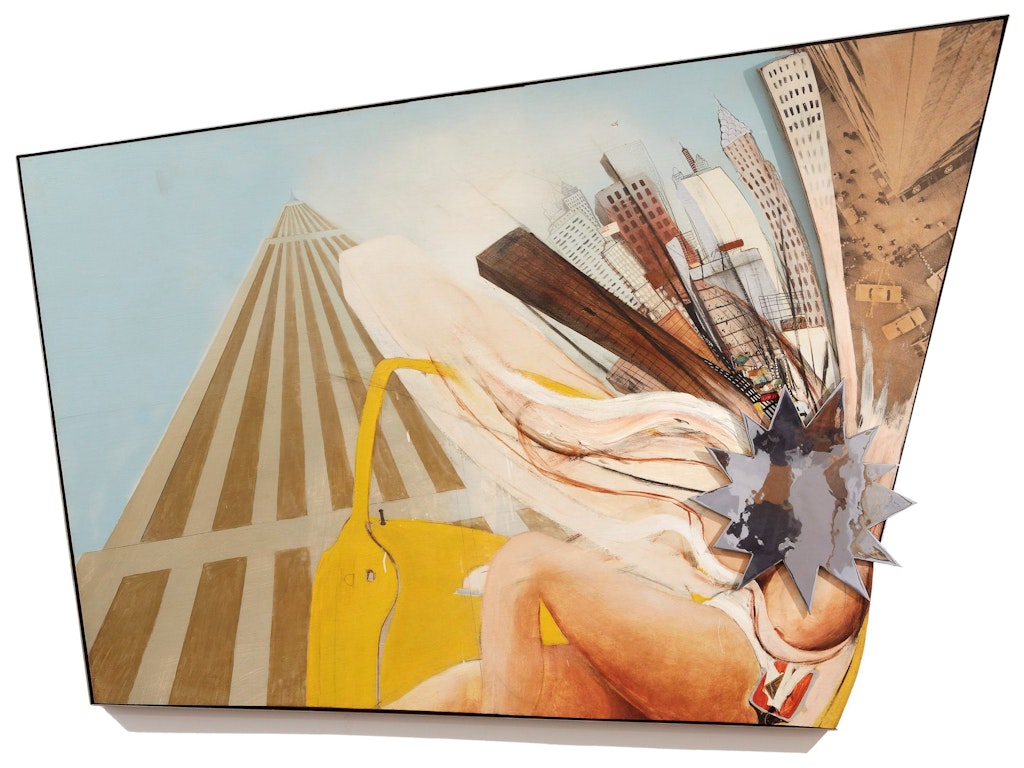
Brett Whiteley New York 1 1968, Brett Whiteley Studio collection © Wendy Whiteley / Copyright Agency
The exhibition Chapters 1959–69 at the Brett Whiteley Studio presents Brett Whiteley’s work during a formative decade of artistic experimentation and travel when he was between the ages of 20 and 30.
Encounters with art, landscapes, people, music and the political and social concerns of the moment were the conduits through which the artist engaged with the world and developed his practice.
While Brett and his wife Wendy were based predominantly in London (1960–67) and New York City (1967–69), they also travelled extensively in Europe and visited India and Morocco. They returned once to Australia during the summer of 1965–66.
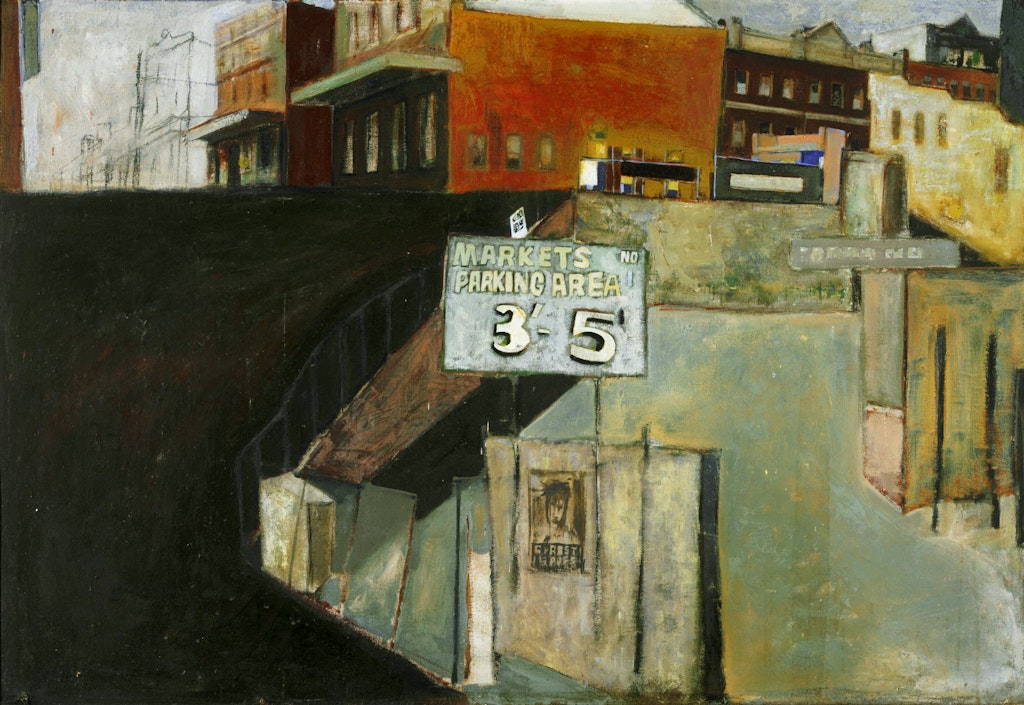
Brett Whiteley Dixon Street 1959, Brett Whiteley Studio collection © Wendy Whiteley / Copyright Agency
Brett Whiteley Dixon Street 1959, Brett Whiteley Studio collection © Wendy Whiteley / Copyright Agency
The journey through Chapters 1959–69 displays the intensity and ambition of the young Whiteley. In Dixon Street 1959, one of four paintings for which he was awarded the Italian Government Art Scholarship in October 1959 – judged by Russell Drysdale and presented at the Art Gallery of New South Wales – Whiteley adopts a high horizon line and earthy palette to shape a complex composition. Rather than create a realistic picture of the inner Sydney street, he reveals his interest in melding elements of representation with abstraction, his aptitude for drawing, and his early use of text and collage in his imagery.
Whiteley left for Italy in early 1960. The scholarship gave him the opportunity to live and work there for ten months, amid the art and architecture of great museums, churches and historical sites of Europe. In June of that year, he was joined in Paris by his girlfriend from Sydney, Wendy Julius, who described seeing work by Giotto in the Louvre as ‘one of the most powerful experiences we shared. We were holding hands and a charge zapped through us.’
Curator Barry Pearce has suggested that the storyboard predella style from Giotto and other Renaissance altarpieces would reemerge in Whiteley’s assemblage paintings from the mid-1960s, in the form of small boxes or sectional panels, embedded within his work and containing objects or photos to expand the picture’s narrative.
In 1961, having settled in London, Whiteley was awarded a grant under the Dyason Bequest from the Art Gallery, which enabled him to remain overseas. Three of Whiteley’s paintings had been selected for the Survey of Recent Australian Painting at the Whitechapel Gallery, and one work, Untitled red painting 1960, was purchased by the Tate, making Whiteley the youngest artist to have work collected by the influential institution.
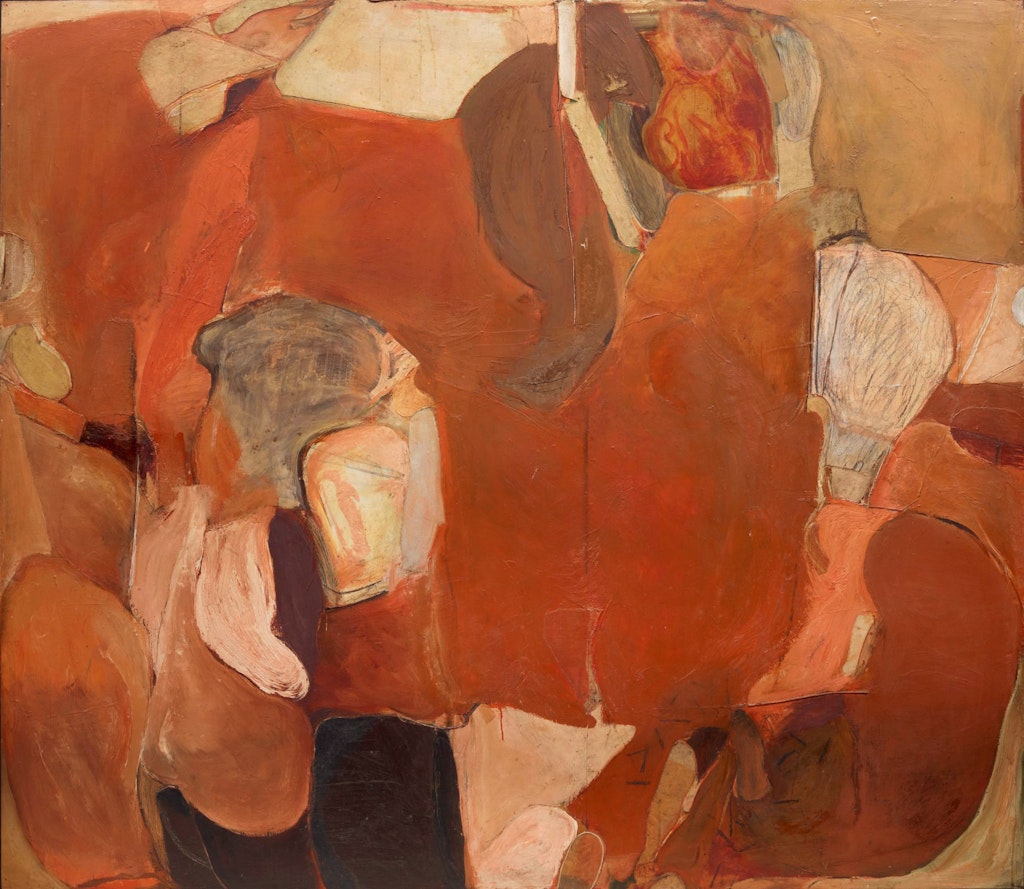
Brett Whiteley Somewhere in summer 1961, Brett Whiteley Studio collection © Wendy Whiteley / Copyright Agency
Brett Whiteley Somewhere in summer 1961, Brett Whiteley Studio collection © Wendy Whiteley / Copyright Agency
In March 1962 Brett and Wendy were married and much of this year was spent travelling extensively throughout Europe with a trip to the United States. Works in Chapters 1959–69 chart Whiteley’s focus at this time on abstraction, and his return to figurative painting that developed during a five-month stay in the small French town of Sigean in 1962.
Whiteley approached abstraction primarily through his interest in landscape, adapting a high horizon line to create a sense of depth, or the illusion of cutting through the ground and tunnelling underneath. Simultaneously, the amorphous flattened sections within the abstractions such as Somewhere in summer 1961 evoke a bird’s-eye view of a much larger, more encompassing scene.
In the works made at Sigean, the warm landscapes are transformed by shapes that suggest the human form: skin over skin, arms, legs, buttocks and torsos appear to be interwoven with speckled patterns suggesting rows of vineyards and olive groves. The coexistence of these elements was a turning point that led Whiteley to embrace a more expansive and experimental approach to his art, incorporating his daily life and surrounds with new-found confidence.
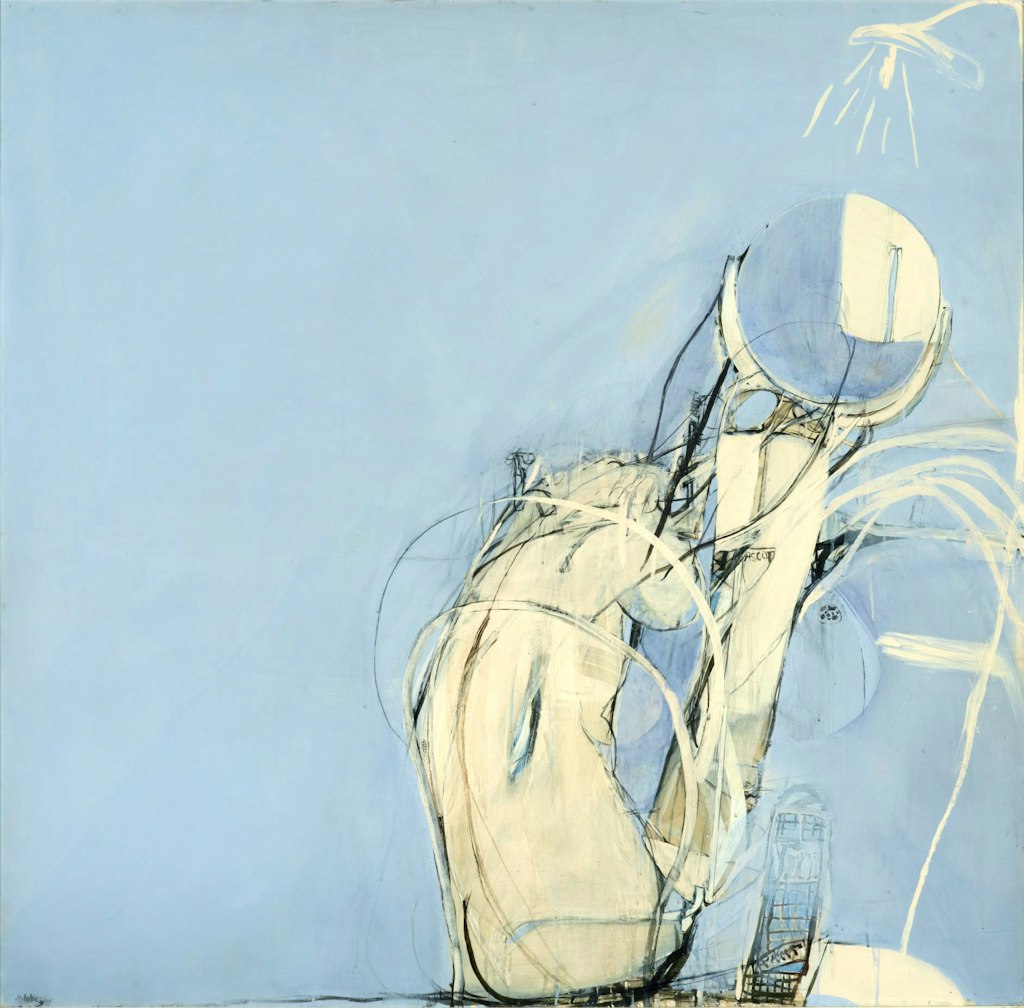
Brett Whiteley Bather and mirror (second version) 1964, Brett Whiteley Studio Collection © Wendy Whiteley / Copyright Agency
Brett Whiteley Bather and mirror (second version) 1964, Brett Whiteley Studio Collection © Wendy Whiteley / Copyright Agency
Returning to London, Whiteley began to zone in on images within his domestic environment: in particular, images of Wendy bathing. These works developed into the Bathroom series – made between 1963 and 1964 – a group of intimate pictures that demonstrate Whiteley’s skill in distilling movement through restrained line and a restricted palette. The bathroom works are layered with gesture and tension; the female form crouched into a tub or leaning over a basin, entwined with smooth shapes and lines that articulate aspects of the room.
Exhibited at the Marlborough New London gallery in April 1964, the Bathroom series also reflects Whiteley’s absorption of important artistic influences, including Pierre Bonnard, whose bathroom pictures were known to the artist, and Francis Bacon, whom Whiteley met in London and became friends with. Bacon’s own images of the human form were an intense wrestle of dualities that would have a lifelong impact on the young artist; a complex exploration of life and death, pleasure and pain, silence and noise.
Whiteley’s interest in states of duality is evident in the Christie and London Zoo series, made simultaneously during 1964–65. The Whiteleys had lived near 10 Rillington Place in Notting Hill, where the murderer and necrophile John Christie had brutally killed several women during the 1940s and early 1950s and entombed them inside the walls of his house.
Whiteley became obsessed with the Christie murders, visiting the Madame Tussaud’s waxworks, where a Chamber of Horrors had a room dedicated to the killer, and he began a series of paintings, drawings and sculpture responding to their immeasurable violence.
These works, a contortion of disfigured limbs, tubes and ropes, bed linen and scrawling texts, are frenzied and claustrophobic, and contrast dramatically with the sensual domesticity of the Bathroom series.
Between June and August 1965, Whiteley visited the London Zoo numerous times, observing and sketching animals in their enclosures, including giraffes, chimpanzees, hyenas and lions. He was fascinated by the behaviour of animals, along with their physicality and appearance. The Christie and London Zoo works were exhibited together at the Marlborough New London gallery in October 1965 and are bridged by an interest in uncontrollable behaviour – one at the hands of a human being, the other by animals whose restraint is limited by instinct and habit.
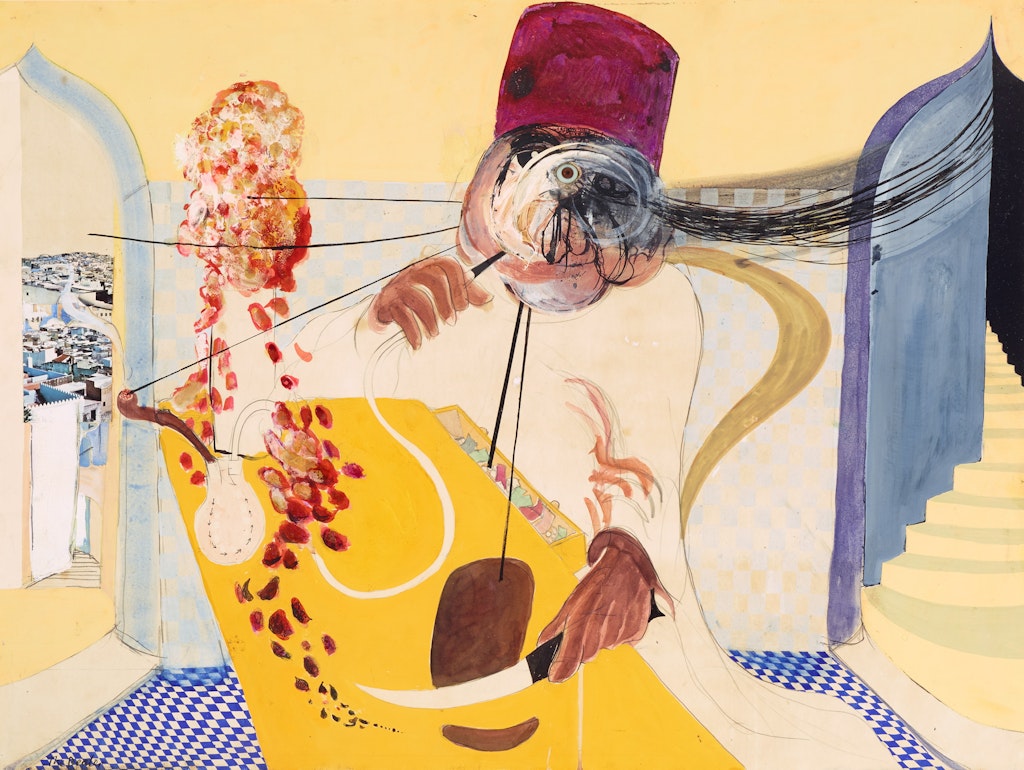
Brett Whiteley The dealer (Tangier postcard) 1967, Art Gallery of New South Wales © Wendy Whiteley/Copyright Agency
In 1967 Whiteley was awarded a Harkness Fellowship that enabled him to work in the United States. The young family packed up their life in London (daughter Arkie was born in November 1964) and travelled to America via Morocco, where they would live for several months in Tangier in the rundown Hotel Majestic. Over this period, Whiteley made a series of 18 ‘postcards’ including The dealer (Tangier postcard) 1967, a portrait of a local hashish dealer who the artist met. Holding a hookah pipe to his mouth and slicing through a large piece of hashish, the details of the dealer’s face are obscured by a lashing of paint and a single glass ‘evil eye’ embedded in the centre of his forehead. The dealer embodies the porosity of art and life for Whiteley. Life revolved around the production of art, and art was completely absorbed with the experience of life.
Arriving in Manhattan later that year, Brett, Wendy and Arkie moved into the Chelsea Hotel on West 23rd Street. He also rented a loft opposite the hotel for his studio space. Whiteley was initially taken by the energy of New York City and was quoted in Time magazine as calling it a ‘living sculpture’.
However, this optimism was short-lived, and he became deeply disenchanted by the social and political unrest that defined the period, including the escalation of the Vietnam War and the assassinations of John F Kennedy and Martin Luther King Jr. In May to June of 1968, Whiteley held an exhibition of new work at Marlborough-Gerson Gallery. In a review, Arts magazine wrote that one work ‘vividly diagnoses the hopeless moral-military-political dilemma of the Pentagon, Vietnam War and culture’.
Following this exhibition, Whiteley began work on his major project from the period, The American dream 1968–69, an 18-panelled ‘dystopian horror’ addressing the decay of a nation in social and political crisis. Marlborough-Gerson Gallery refused to exhibit it and in July 1969, Whiteley abruptly left the United States and flew to Fiji.

Brett Whiteley The green mountain (Fiji) 1969, Art Gallery of New South Wales © Wendy Whiteley / Copyright Agency 2024
Brett Whiteley The green mountain (Fiji) 1969, Art Gallery of New South Wales © Wendy Whiteley / Copyright Agency 2024
Arriving in tropical paradise, he purchased a Mini Moke and rented a bure (a wood and straw hut) in a village called Navutulevu, about 100 km along the coast from the capital Suva. After packing up their life in New York, Wendy and Arkie joined Brett who had begun to paint a series of panels that captured the beauty and lushness of the Fijian landscape – the ocean, birds and rainforest – regulated only by the weather and the natural rhythms of night and day. After the chaos and turbulence of the United States, Fiji was a place of simplicity and refuge.
The family intended to stay in Fiji permanently, but Whiteley was caught in possession of a small amount of opium and directed to leave immediately. In November 1969, almost a decade to the day after he had departed Australia, the Whiteley family arrived back in Sydney where they would settle in Lavender Bay on the lower North Shore. The 1970s would mark a new chapter in Whiteley’s work, an internal turn focused on the intricacies of life in this country.
A version of this article first appeared in Look – the Gallery’s members magazine